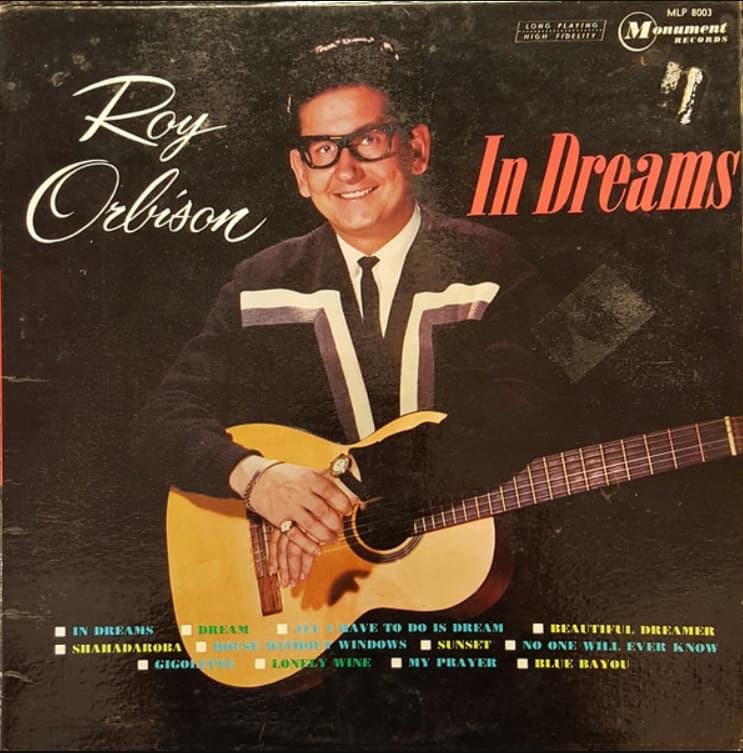
Roy Orbison – “In Dreams”: A Haunting, Poetic Vision of Longing and Love Lost
Roy Orbison’s “In Dreams” is a masterful ballad that captures the beauty, heartbreak, and surreal nature of unrequited love. Released in 1963, the song showcases Orbison’s unique ability to blend operatic vocals, emotional intensity, and vivid storytelling. Known for its haunting melody and dreamlike lyrics, “In Dreams” has become one of Orbison’s most celebrated tracks, embodying the timeless themes of longing, loss, and the elusive nature of love. With its cinematic quality and Orbison’s ethereal vocal delivery, the song is a perfect blend of rock, pop, and operatic balladry, evoking a world where dreams offer solace, if only temporarily.
The song begins with a gentle, almost hypnotic melody, setting a wistful tone that immediately draws the listener into its otherworldly atmosphere. Orbison’s vocals enter softly, as though he’s recounting a dream, with a sense of quiet reverence. The gentle instrumentation, marked by soft guitar and subtle orchestration, creates an ethereal soundscape that mirrors the fragility and beauty of a dream. This opening captures the feeling of drifting into a subconscious world where anything is possible and yet fleeting.
Lyrically, “In Dreams” tells the story of a man who finds himself with his lost love in a dream. The phrase “A candy-colored clown they call the Sandman” introduces this surreal world, where the narrator can be with the one he loves, if only for a brief moment. Lines like “In dreams I walk with you, in dreams I talk to you” convey the intense emotional pull of this fantasy, where the narrator experiences a love that feels as real as life itself. But as the dream inevitably fades, the narrator is left with the heartache of knowing that his love only exists in these ephemeral visions. The lyrics’ simplicity and clarity amplify their poignancy, making the song both personal and universal.
The chorus, “But just before the dawn, I awake and find you gone,” captures the bittersweet moment of waking and realizing that the love he’s experienced was only a dream. This line, repeated with increasing intensity, emphasizes the painful realization that dreams, no matter how beautiful, cannot alter reality. The refrain is both a lament and an acceptance, capturing the sadness of holding onto something that can never truly be. This yearning and heartbreak are timeless emotions, making the song resonate with anyone who has experienced a love that feels out of reach.
Orbison’s vocal performance is the heart of “In Dreams.” His voice is both powerful and tender, capturing the vulnerability and intensity of his emotions. Known for his impressive range and unique voice, Orbison sings with a haunting quality that brings the lyrics to life. He delivers each line with sincerity, creating a sense of intimacy that makes the listener feel as though they’re experiencing the dream with him. As he moves into the higher registers, his voice rises with emotion, conveying the narrator’s desperation to hold onto this love. Orbison’s control and sensitivity make his vocal performance unforgettable, leaving a lasting impression on anyone who hears it.
The musical arrangement of “In Dreams” is carefully crafted to enhance its surreal and melancholic themes. The subtle strings, delicate guitar, and background harmonies create a rich, layered sound that evokes the dreamlike quality of the lyrics. The orchestration swells and recedes, mirroring the waves of emotion that wash over the narrator as he moves through the dream and awakens to reality. The song’s structure, which builds slowly to an emotional climax before fading away, reflects the experience of slipping in and out of dreams, reinforcing the song’s themes of longing and impermanence.
“In Dreams” gained renewed attention when it was featured in David Lynch’s 1986 film Blue Velvet, introducing it to a new generation and highlighting its haunting, almost cinematic quality. Lynch’s use of the song in a dark, surreal context resonated with the themes of love, desire, and loss, solidifying “In Dreams” as a song that transcends simple love balladry. The song’s dreamlike feel and haunting beauty have made it a cultural touchstone, inspiring artists across genres and continuing to capture listeners’ imaginations.
Over time, “In Dreams” has become one of Roy Orbison’s most iconic songs, celebrated for its emotional depth and artistic sophistication. Its themes of love, loss, and longing are timeless, allowing it to connect with listeners across generations. Orbison’s voice, paired with the song’s haunting melody and evocative lyrics, creates a piece that feels like an experience as much as a song—a journey into the fragile, ethereal world of dreams where love, however fleeting, feels real.
In the end, “In Dreams” is more than a song; it’s a beautifully crafted story of love that exists beyond the boundaries of reality. Roy Orbison’s haunting vocals and poetic lyrics make it a timeless classic, a song that invites listeners to experience the bittersweet beauty of dreaming about a love that can never be. For fans of poignant ballads and evocative storytelling, “In Dreams” remains a powerful testament to the enduring power of music to capture the deepest corners of the human heart.